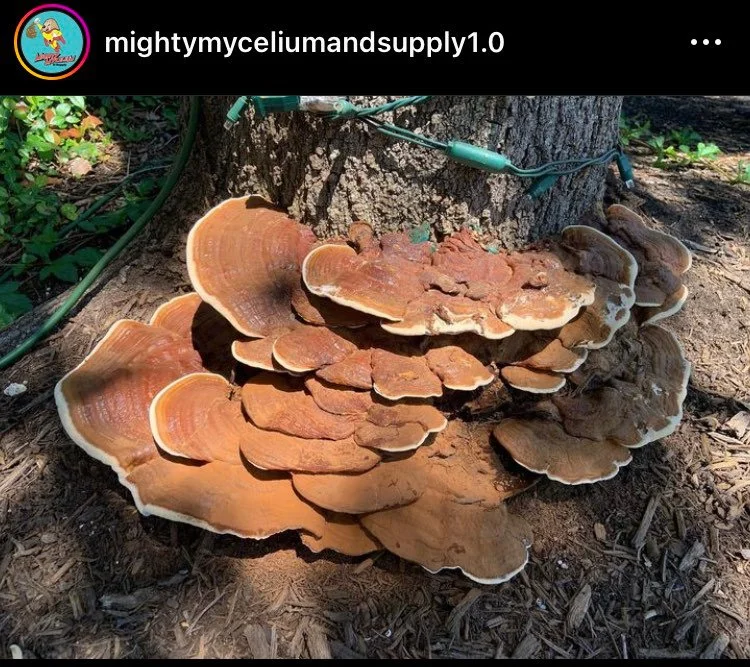 Image 1 of 7
Image 1 of 7

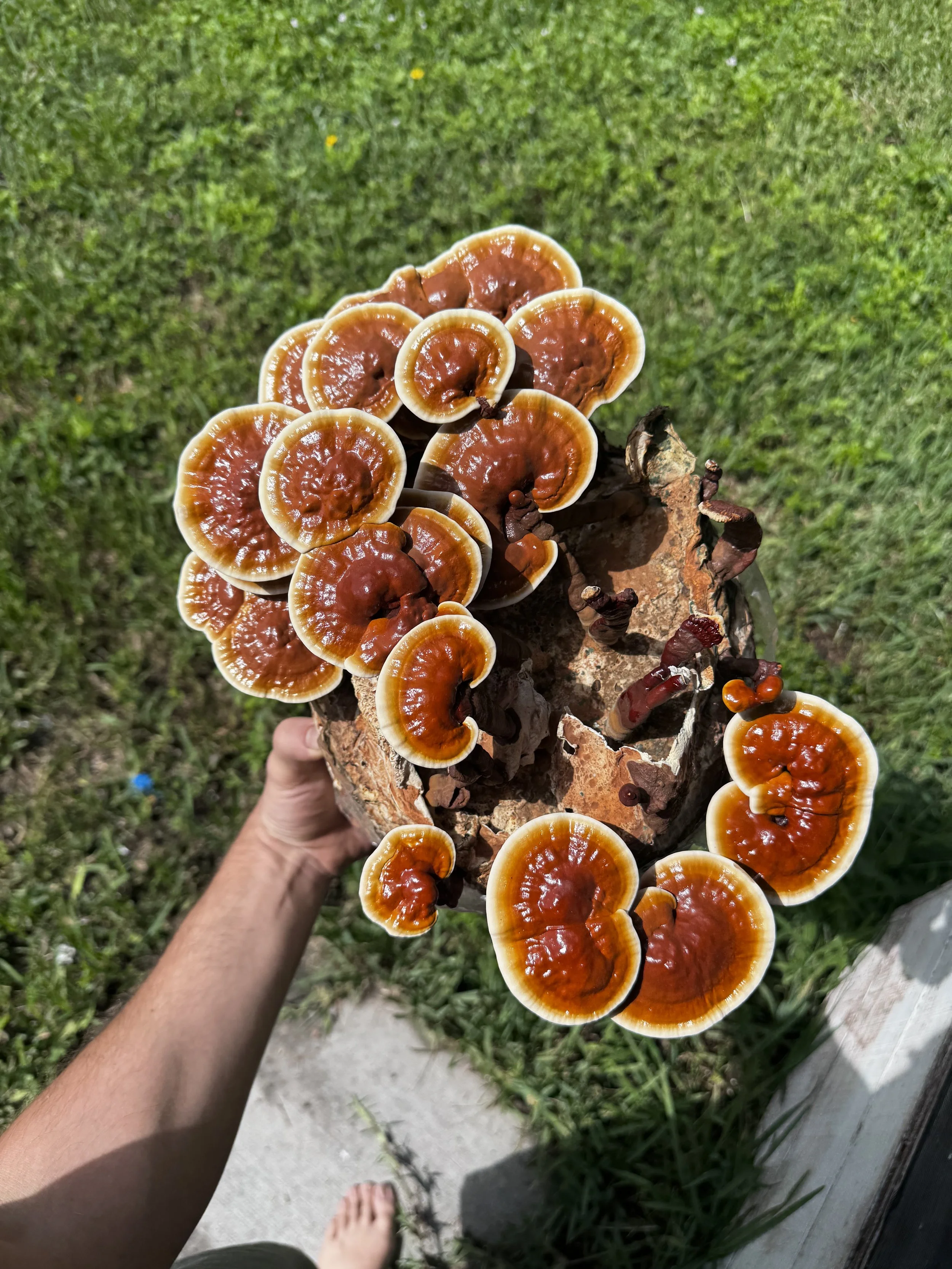 Image 2 of 7
Image 2 of 7

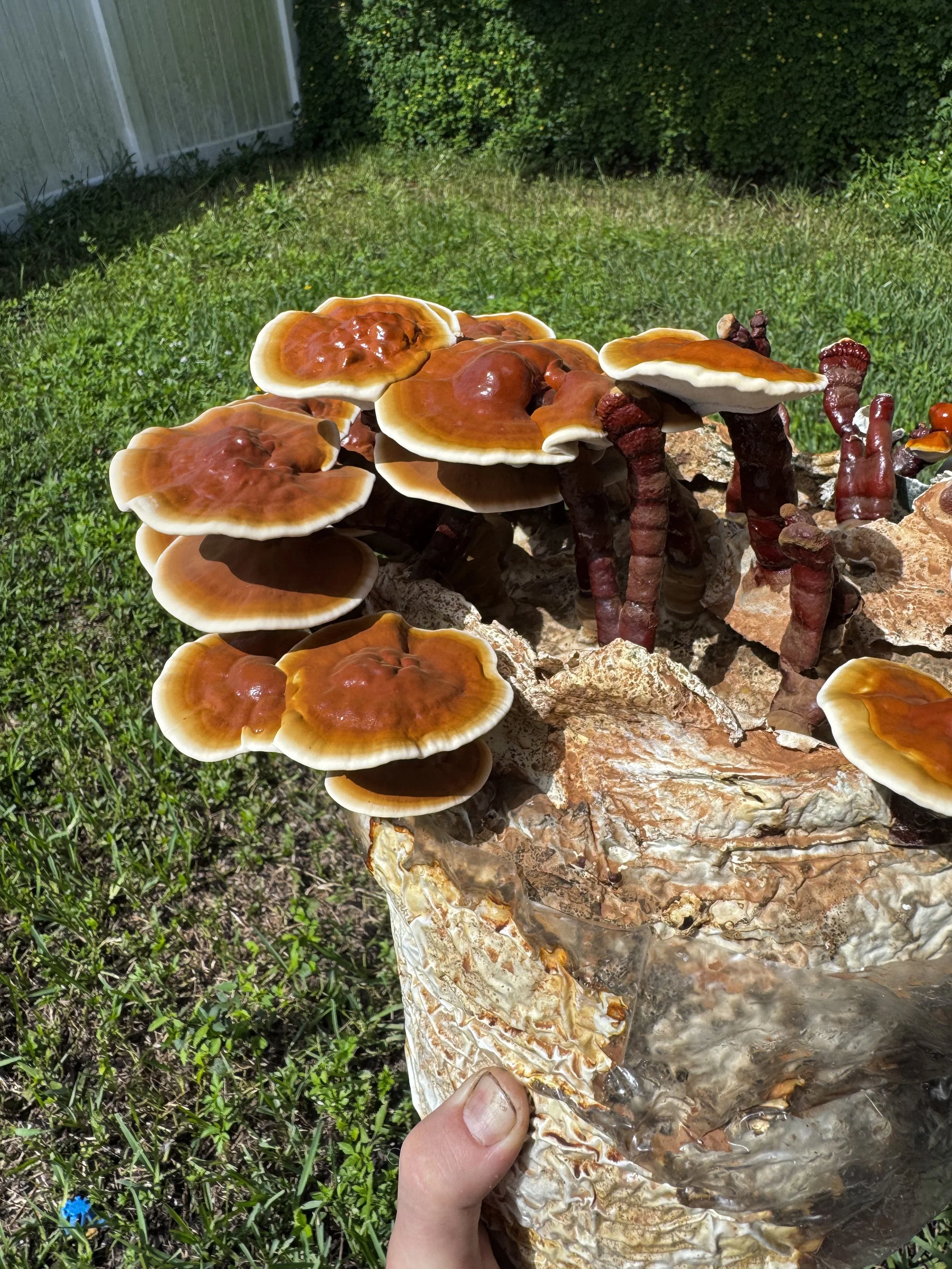 Image 3 of 7
Image 3 of 7

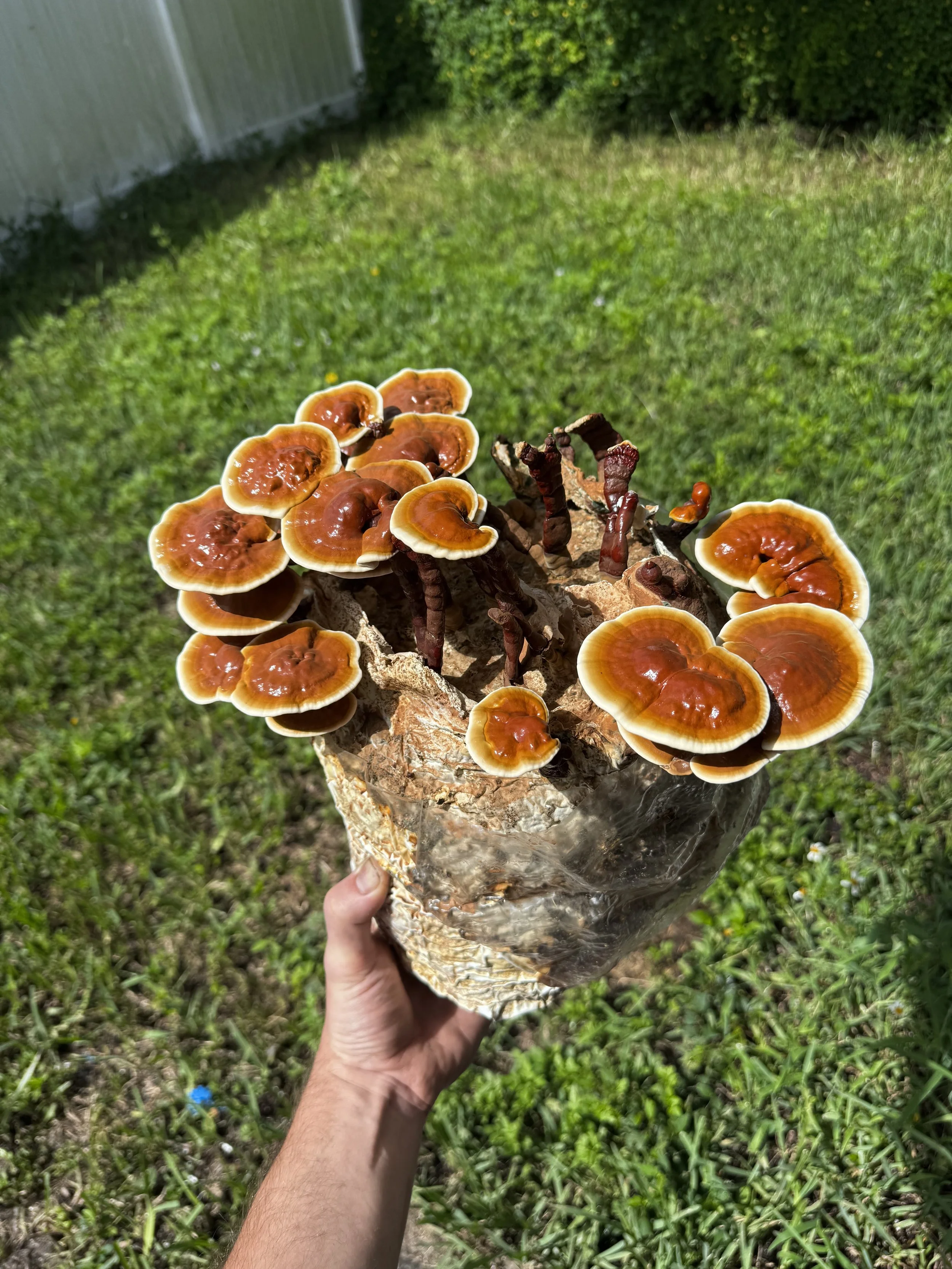 Image 4 of 7
Image 4 of 7

 Image 5 of 7
Image 5 of 7

 Image 6 of 7
Image 6 of 7

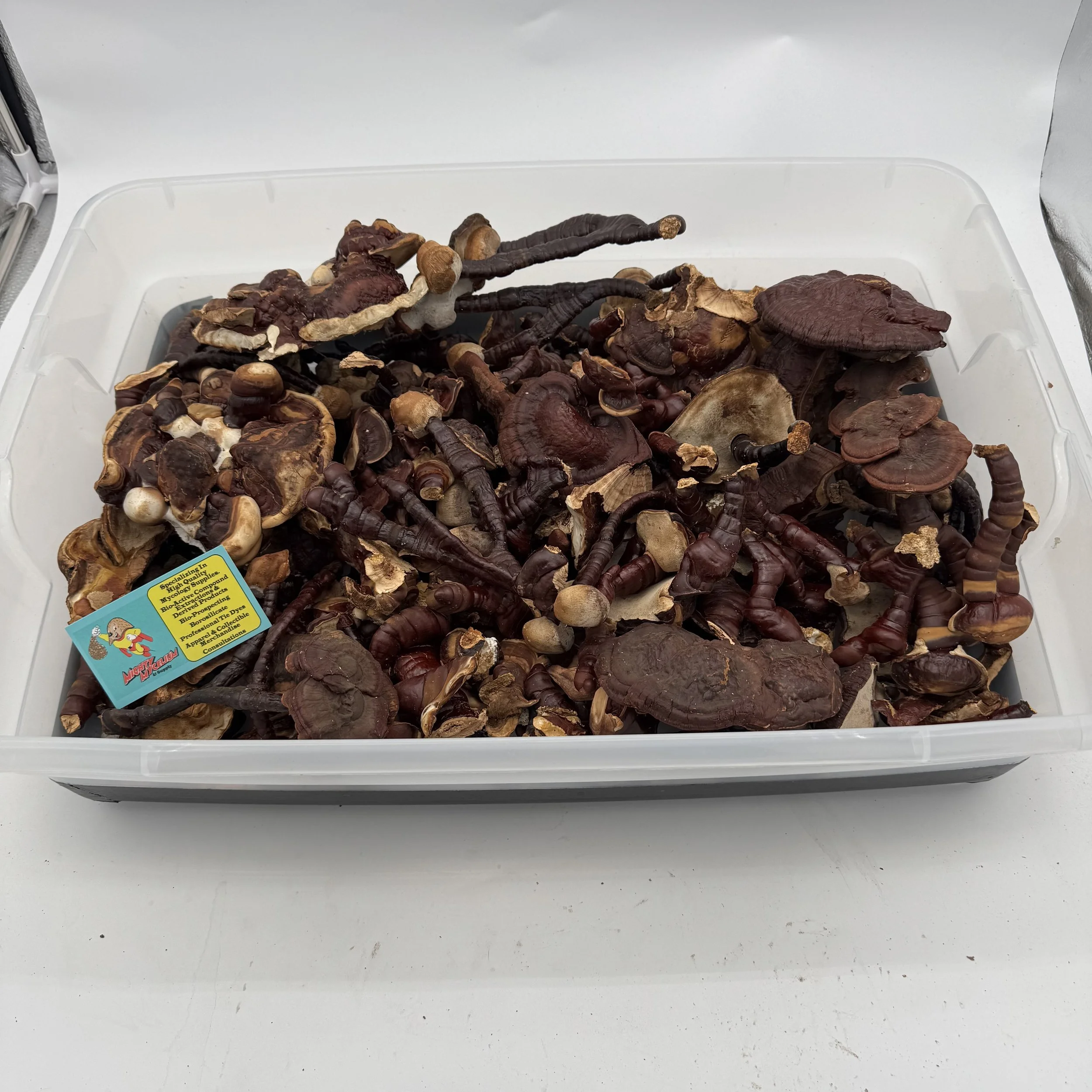 Image 7 of 7
Image 7 of 7








Mega Reishi (Ganoderma Sessile) Liquid Culture Syringe
The Most AGGRESSIVE Reishi I’ve Ever Encountered!
While walking through a park in North Houston, I stumbled upon something extraordinary—an enormous cluster of Ganoderma lucidum (Reishi) growing at the base of a dying oak tree. But this wasn’t your average forest find. This beast of a mushroom had completely enveloped the outlet from a string of Christmas lights, as if it were feeding off the raw electricity. They say mushrooms grow where lightning strikes—this one looked like it was plugged directly into the grid.
Most wild Reishi sightings yield a lone antler or the occasional conk, but this was a thick, vibrant colony unlike anything I’d seen before. I let it reach full maturity before harvesting a chunk of tissue from the largest cap and bringing it home to clone. Since then, it’s consistently produced long, meaty antlers that conk beautifully as oxygen levels rise.
This strain is a powerhouse.
We offer fresh-made Agar plates, Slants, Liquid Cultures, and Spore Prints, all prepped to order in a sterile environment. Please allow 3–5 business days for processing before shipment.
“Mega” Reishi (Ganoderma Sessile): Houston area bio-prospected specimen.
This sample was originally taken during the summer of 2022 while my son and I were walking at The Woodlands Waterway. Right outside the pavilion sat the gnarliest cluster of Reishi conks that I have ever seen! It grew over the end of some Christmas lights (which were left out for some reason). It appeared as though it could be syphoning electricity off the connection/ outlet. It’s said in nature that electricity from lightning will result in fruit bodies to form in that area. This is why you may or may not have heard of that guy who was tasing his monotubs based on this theory.
My Mega Reishi culture will put out amazing antlers as well as gorgeous conks if it’s allowed enough air exchange. The extract resin from this cultigen is Phenomenal for immune support. Reishi is known for its relaxing effects, resulting in more restful sleep.
Grown with love by yours truly! ;) With an added touch of southern hospitality.
Organically, and locally grown milo is our go to when inoculating our Hardwood sawdust-based substrates.
Here’s a comprehensive profile of Ganoderma sessile, a wood-decaying bracket fungus commonly found in Texas and other parts of North America. This species is closely related to the more well-known Ganoderma lucidum (Reishi) but has distinct morphological and ecological traits.
🍄 Ganoderma sessile: Overview
Feature Detail Common Name None widely accepted (sometimes called “Reishi-like” or "sessile Ganoderma") Scientific Name Ganoderma sessile Described by Murrill (1902) Family Ganoderma taceae Ecological Role Saprotroph and parasite (wood-decaying) Habitat Dead or dying hardwoods (esp. oaks) Distribution Widely distributed in the U.S., especially in the East, Southeast, and Texas
🔬 Taxonomy of Ganoderma sessile
RankClassificationDomainEukaryotaKingdomFungiPhylumBasidiomycotaClassAgaricomycetesOrderPolyporalesFamilyGanodermataceaeGenusGanodermaSpeciesGanoderma sessile AuthorityMurrill (1902)
🧬 Biological and Morphological Characteristics
🔹 Fruiting Body (Conk)
Shape: Semi-circular to fan-shaped
Size: 5–30 cm across, can grow large in optimal conditions
Cap Surface: Lacquered-looking, shiny when fresh; often dark reddish-brown to black
Texture: Woody and tough
Stem (stipe): Typically absent or very short—hence the name sessile (“sitting directly on the substrate”)
Pores: Tiny and white when fresh; bruise brown with age
Spore Print: Brown
Spores: Double-walled, with ornamented surface—typical of Ganoderma
🔹 Hyphal System:
Trimitic (with generative, skeletal, and binding hyphae)
One of the key diagnostic features of Ganoderma species
🌍 Ecology and Distribution
Texas: Very common in East and Central Texas, especially on live oaks, post oaks, and other hardwoods.
Host Trees: Primarily hardwoods—oaks, maples, elms, sweetgum
Habitat: Urban landscapes, parks, natural forests
Ecological Role:
Saprotrophic: Decomposes dead wood
Parasitic: Infects live trees, causing white rot (decay of lignin)
⚠️ Infected trees may suffer structural weakening, posing risks in urban environments.
🌿 Distinguishing Ganoderma sessile from Similar Species
Species Key Differences Ganoderma lucidum Often has a long, distinct stem; typically, Eurasian in origin (rarely native in U.S.) Ganoderma curtisii Similar habitat, may be more yellowish and has more prominent stem in southeastern U.S. Ganoderma applanatum Also sessile, but surface is matte/dull, not shiny; used for artist’s conks Ganoderma tsugae Grows on conifers, especially hemlock (not found in Texas)
Microscopy and DNA sequencing are often needed for confident identification due to overlapping macroscopic traits.
⚕️ Medicinal Potential
Like other Ganoderma species, G. sessile contains bioactive compounds, although it’s less studied than G. lucidum.
Known Constituents:
Triterpenoids
Polysaccharides (e.g. β-glucans)
Ganoderic acids
Antioxidants
Possible Effects:
Anti-inflammatory
Antioxidant
Immunomodulatory
Antitumor (in vitro)
Antimicrobial
🧪 NOTE: Most clinical and pharmacological studies focus on Ganoderma lucidum. While G. sessile shares some chemical profiles, specific clinical studies are lacking.
⚠️ Toxicity and Edibility
Not toxic, but too woody to eat directly
Sometimes brewed as medicinal tea or tincture
Avoid wild harvesting unless properly identified—Ganoderma species can be tricky to distinguish and may host harmful molds if degraded
📸 Identification in the Wild (Texas Focus)
When to Look: Late Spring to fall (moist conditions favor fruiting)
Where to Look:
On base or trunk of dead/dying hardwoods
Around tree stumps or roots
Common in urban parks, riparian areas, and hardwood forests
📚 Historical and Taxonomic Notes
First described by William Alphonso Murrill, a mycologist who worked extensively on North American polypores
Long grouped with G. lucidum in older literature; now recognized as distinct based on morphology and molecular data
✅ Summary: Key Points on Ganoderma sessile
A hard, shelf-like polypore fungus found widely in Texas and across the U.S.
Grows without a stalk (sessile), with a shiny reddish-brown surface
Ecologically important as both a decomposer and tree pathogen
Medicinal potential exists but not thoroughly studied
Can be confused with other Ganoderma species, especially without lab analysis
The Most AGGRESSIVE Reishi I’ve Ever Encountered!
While walking through a park in North Houston, I stumbled upon something extraordinary—an enormous cluster of Ganoderma lucidum (Reishi) growing at the base of a dying oak tree. But this wasn’t your average forest find. This beast of a mushroom had completely enveloped the outlet from a string of Christmas lights, as if it were feeding off the raw electricity. They say mushrooms grow where lightning strikes—this one looked like it was plugged directly into the grid.
Most wild Reishi sightings yield a lone antler or the occasional conk, but this was a thick, vibrant colony unlike anything I’d seen before. I let it reach full maturity before harvesting a chunk of tissue from the largest cap and bringing it home to clone. Since then, it’s consistently produced long, meaty antlers that conk beautifully as oxygen levels rise.
This strain is a powerhouse.
We offer fresh-made Agar plates, Slants, Liquid Cultures, and Spore Prints, all prepped to order in a sterile environment. Please allow 3–5 business days for processing before shipment.
“Mega” Reishi (Ganoderma Sessile): Houston area bio-prospected specimen.
This sample was originally taken during the summer of 2022 while my son and I were walking at The Woodlands Waterway. Right outside the pavilion sat the gnarliest cluster of Reishi conks that I have ever seen! It grew over the end of some Christmas lights (which were left out for some reason). It appeared as though it could be syphoning electricity off the connection/ outlet. It’s said in nature that electricity from lightning will result in fruit bodies to form in that area. This is why you may or may not have heard of that guy who was tasing his monotubs based on this theory.
My Mega Reishi culture will put out amazing antlers as well as gorgeous conks if it’s allowed enough air exchange. The extract resin from this cultigen is Phenomenal for immune support. Reishi is known for its relaxing effects, resulting in more restful sleep.
Grown with love by yours truly! ;) With an added touch of southern hospitality.
Organically, and locally grown milo is our go to when inoculating our Hardwood sawdust-based substrates.
Here’s a comprehensive profile of Ganoderma sessile, a wood-decaying bracket fungus commonly found in Texas and other parts of North America. This species is closely related to the more well-known Ganoderma lucidum (Reishi) but has distinct morphological and ecological traits.
🍄 Ganoderma sessile: Overview
Feature Detail Common Name None widely accepted (sometimes called “Reishi-like” or "sessile Ganoderma") Scientific Name Ganoderma sessile Described by Murrill (1902) Family Ganoderma taceae Ecological Role Saprotroph and parasite (wood-decaying) Habitat Dead or dying hardwoods (esp. oaks) Distribution Widely distributed in the U.S., especially in the East, Southeast, and Texas
🔬 Taxonomy of Ganoderma sessile
RankClassificationDomainEukaryotaKingdomFungiPhylumBasidiomycotaClassAgaricomycetesOrderPolyporalesFamilyGanodermataceaeGenusGanodermaSpeciesGanoderma sessile AuthorityMurrill (1902)
🧬 Biological and Morphological Characteristics
🔹 Fruiting Body (Conk)
Shape: Semi-circular to fan-shaped
Size: 5–30 cm across, can grow large in optimal conditions
Cap Surface: Lacquered-looking, shiny when fresh; often dark reddish-brown to black
Texture: Woody and tough
Stem (stipe): Typically absent or very short—hence the name sessile (“sitting directly on the substrate”)
Pores: Tiny and white when fresh; bruise brown with age
Spore Print: Brown
Spores: Double-walled, with ornamented surface—typical of Ganoderma
🔹 Hyphal System:
Trimitic (with generative, skeletal, and binding hyphae)
One of the key diagnostic features of Ganoderma species
🌍 Ecology and Distribution
Texas: Very common in East and Central Texas, especially on live oaks, post oaks, and other hardwoods.
Host Trees: Primarily hardwoods—oaks, maples, elms, sweetgum
Habitat: Urban landscapes, parks, natural forests
Ecological Role:
Saprotrophic: Decomposes dead wood
Parasitic: Infects live trees, causing white rot (decay of lignin)
⚠️ Infected trees may suffer structural weakening, posing risks in urban environments.
🌿 Distinguishing Ganoderma sessile from Similar Species
Species Key Differences Ganoderma lucidum Often has a long, distinct stem; typically, Eurasian in origin (rarely native in U.S.) Ganoderma curtisii Similar habitat, may be more yellowish and has more prominent stem in southeastern U.S. Ganoderma applanatum Also sessile, but surface is matte/dull, not shiny; used for artist’s conks Ganoderma tsugae Grows on conifers, especially hemlock (not found in Texas)
Microscopy and DNA sequencing are often needed for confident identification due to overlapping macroscopic traits.
⚕️ Medicinal Potential
Like other Ganoderma species, G. sessile contains bioactive compounds, although it’s less studied than G. lucidum.
Known Constituents:
Triterpenoids
Polysaccharides (e.g. β-glucans)
Ganoderic acids
Antioxidants
Possible Effects:
Anti-inflammatory
Antioxidant
Immunomodulatory
Antitumor (in vitro)
Antimicrobial
🧪 NOTE: Most clinical and pharmacological studies focus on Ganoderma lucidum. While G. sessile shares some chemical profiles, specific clinical studies are lacking.
⚠️ Toxicity and Edibility
Not toxic, but too woody to eat directly
Sometimes brewed as medicinal tea or tincture
Avoid wild harvesting unless properly identified—Ganoderma species can be tricky to distinguish and may host harmful molds if degraded
📸 Identification in the Wild (Texas Focus)
When to Look: Late Spring to fall (moist conditions favor fruiting)
Where to Look:
On base or trunk of dead/dying hardwoods
Around tree stumps or roots
Common in urban parks, riparian areas, and hardwood forests
📚 Historical and Taxonomic Notes
First described by William Alphonso Murrill, a mycologist who worked extensively on North American polypores
Long grouped with G. lucidum in older literature; now recognized as distinct based on morphology and molecular data
✅ Summary: Key Points on Ganoderma sessile
A hard, shelf-like polypore fungus found widely in Texas and across the U.S.
Grows without a stalk (sessile), with a shiny reddish-brown surface
Ecologically important as both a decomposer and tree pathogen
Medicinal potential exists but not thoroughly studied
Can be confused with other Ganoderma species, especially without lab analysis

